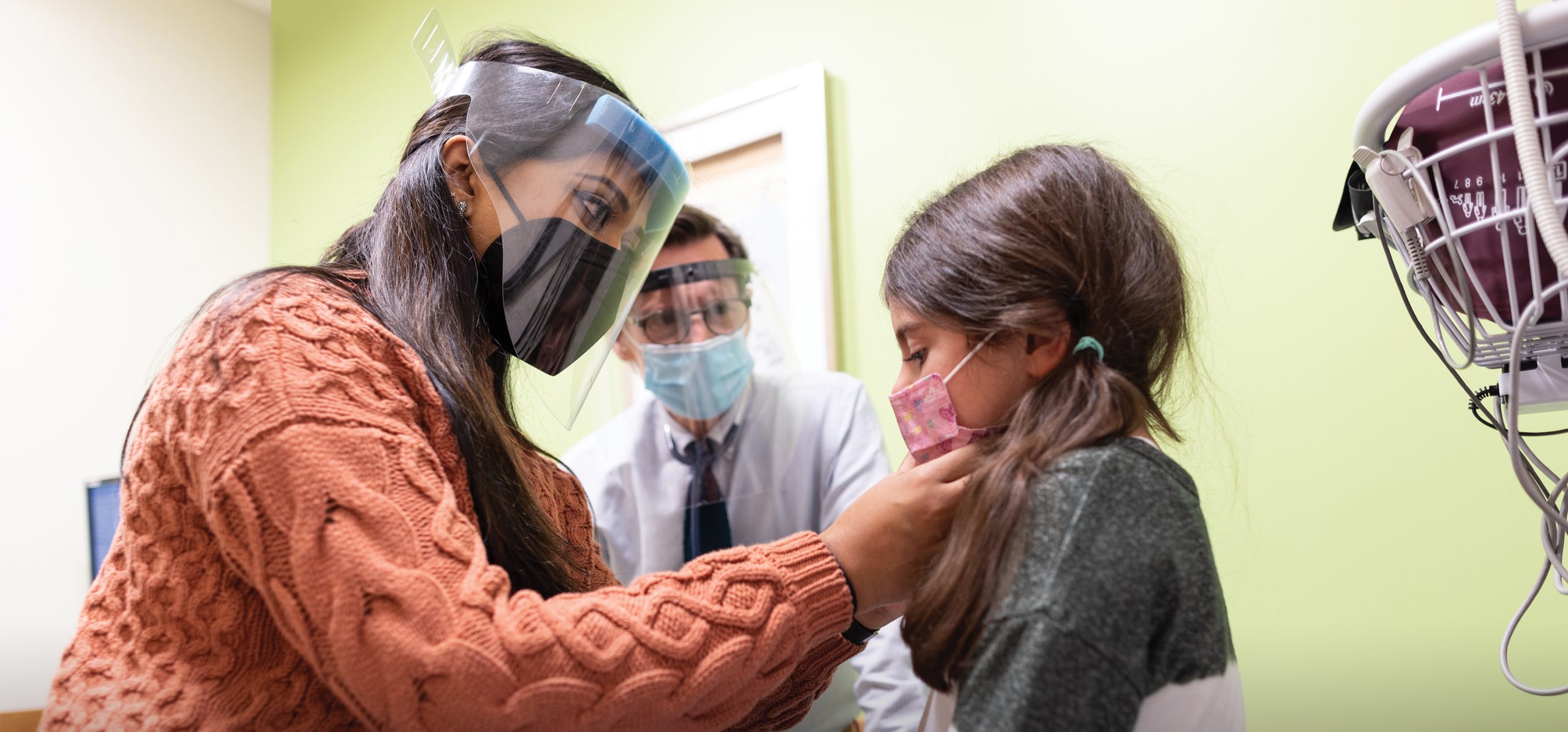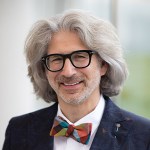
First-year Einstein medical student Riya Thomas is just a few years behind her older brother, Rony Thomas, M.D. ’21, soon to begin his residency in interventional radiology at Montefiore—but her Einstein learning experience already has been vastly different.
That’s because Ms. Thomas and the other members of the Class of 2025 are the first students to be taking part in a curriculum that is in the midst of a transformation at Einstein, brought about by a rapidly evolving world of medicine.
“From conversations with my brother, I’m finding that my curriculum is more accelerated than his was, and it requires you to be more efficient with your time,” Ms. Thomas says. “For example, his anatomy course ran until April. Mine wrapped up in December.”
One difference in their experiences that made that change possible was the use of prosected (precut) cadavers in Ms. Thomas’s first-year anatomy lab. “I’ve heard students from earlier classes say that dissecting itself takes an incredible amount of time. We saved many hours because everything was already cut away for us and labeled by our instructors, who were there at each station to teach us.” (Students interested in pursuing advanced training may go back into the lab in their fourth year and perform dissections for the first-year anatomy course.)

We’re focusing on functional anatomy—not just memorizing, but explaining why students need to know what these hundreds of anatomical structures are.
—Dr. Joshua Nosanchuk
Joshua Nosanchuk, M.D., senior associate dean for medical education and professor of medicine and of microbiology & immunology at Einstein, says the changes in the anatomy course represent a reevaluation of the “core” aspects of medicine being taught. “We’re focusing on functional anatomy—not just memorizing, but explaining why students need to know what these hundreds of anatomical structures are,” says Dr. Nosanchuk, who is also an infectious disease clinician at Montefiore.
To help students make the leap from the lab to real patients, first-years are now also being introduced to radiology during the anatomy course. “Radiology is what we use clinically to view beneath the skin of our patients, and integrating this with traditional cadaver-based anatomy enhances the translation of what our students are learning,” he says.
Moving to prosections and radiology in anatomy are just two of the many medical school curriculum revisions being introduced this year. Other significant changes include:
When COVID-19 hit the Bronx in the spring of 2020, it sped up changes that were already in the works. “The pandemic left no part of our curriculum untouched,” Dr. Nosanchuk says. “We decided early on that we were going to consider how we could not only rapidly and effectively adjust our curriculum to better meet the demands of this crisis and future ones, but also align our training with the needs of our community and healthcare systems.”
An 11-member task force of faculty and students was created. “After a lot of dialogue and consensus-building, they came up with innovative solutions to enhance medical education at Einstein,” Dr. Nosanchuk says. The revamped curriculum was approved by the Liaison Committee on Medical Education, which is Einstein’s accreditation body, on Feb. 1, 2021.
In another step toward transforming the curriculum, Einstein named Janice Thomas John, D.O., M.S., M.P.H., its inaugural assistant dean for integrated medical education in late 2021. “Dr. John will play a critical role in launching and refining a range of new courses across all four years of our educational program,” says Todd Cassese, M.D., associate dean for medical education at Einstein, professor of medicine, and a hospitalist at Montefiore.
From conversations with my brother, I’m finding that my curriculum is more accelerated than his was, and it requires you to be more efficient with your time.
—Riya Thomas
A key task-force recommendation was to integrate basic, health-system, and clinical sciences into all four years of medical school. “Our goal is to ensure that our students’ clinical work is grounded in and informed by science,” Dr. Cassese says. “When they’re taking care of patients in the hospital, they might hear, ‘This patient has pneumonia, so give them ceftriaxone [an antibiotic].’ But we want students to think, ‘Why does this person have pneumonia? What societal factors could have contributed to this person becoming sick (e.g., access to healthcare, food security, living conditions)? What host factors had to fail in order for them to develop this disease? What are the mechanisms of action of this antibiotic? How are these drugs cleared from the body?’ Knowing how the healthcare system works and integrating this with the basic science behind pneumonia—in this case, microbiology—should help them provide better care for their patients.”
For first-year student Ms. Thomas, who is interested in pediatrics, one of the best aspects of the new curriculum is working with actual patients earlier than her brother did. One afternoon a week, she shadows a Montefiore pediatrician in the Bronx, taking medical histories of patients. “Seeing children in the clinic has made a big difference in my medical education,” she says. “I’ve seen babies under the age of 1. They’re not even walking yet. That’s an experience I don’t think I would have ever been able to get in a classroom.”
Another key curriculum innovation: a new, comprehensive course, Health Systems Science and Health Equity, which students will take during all four years.
“Our students will gain an understanding about how our healthcare system works—or doesn’t work—and how they can improve their own clinical ability while also learning their role in changing the system so it becomes more efficient, equitable, and just,” says Oladimeji Oki, M.D., assistant professor and assistant clerkship director of family and social medicine at Einstein and a family practitioner at Montefiore, who directs the new course.
The course includes lectures and case studies on social and structural determinants of health; it covers the specific challenges patients face and possible solutions for achieving better access to quality care.
“Our lecture topics in the course have included things such as climate justice and access to nutrition and food,” Ms. Thomas says. “We’ve also met with different community-based groups to learn about their work and how it affects the people in the Bronx.” Ms. Thomas elected to work with Mott Haven Fridge, a group that brings unsold fruit and vegetables and leftover school meals and restaurant food to community hubs, where the food is distributed to people in need throughout the Bronx.
While medical students will begin engaging with patients in their first semester, their responsibilities for patient care will increase significantly when their clinical clerkships, also known as rotations, begin. To better prepare students for those rotations, Einstein expanded its existing one-week “transition to clerkship” program into a nine-week course.
For the Class of 2025, that transition begins in January of their second year, followed by clerkships in six areas, each six weeks long: general surgery, internal medicine, family medicine and ambulatory care, pediatrics, obstetrics and gynecology, and psychiatry and neurology. The new schedule will provide time for an elective rotation during the clerkship year, allowing students to explore additional specialties before structuring their “extended” fourth year in preparation for residency applications.
Community service—long a tradition at Einstein—has now become a required part of the curriculum across all four years. “This gives students credit for something they’re probably already doing and validates their activities,” Dr. Nosanchuk says. “It’s going to be on their transcripts, which will state very clearly that our students engage in service. And it’s a passion for us.”
The new curriculum ensures that students can have substantial dedicated time for service learning and scholarly activities throughout the academic years, allowing them to make larger commitments—to a volunteer project, an outside organization, or a research lab.
Ms. Thomas, like her brother before her, has been volunteering as a patient advocate at the student-run Einstein Community Health Outreach clinic.
“At Einstein you have so many options for getting involved. It’s a really great place to learn—more than just being taught medical science in the classroom. You’ll discover a lot about the people you will be serving,” she says.